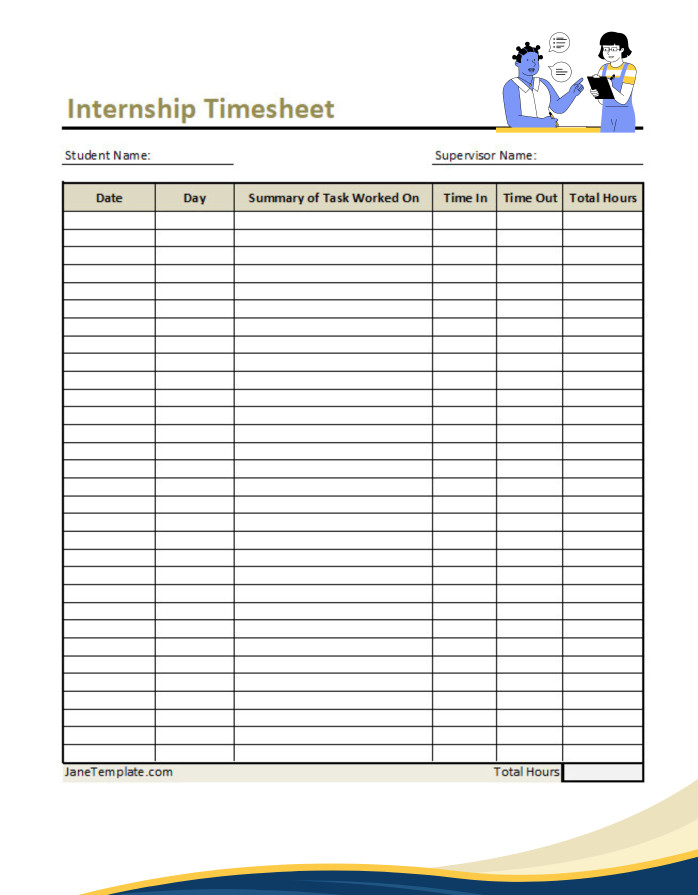Internships are an essential part of gaining real-world experience and preparing for a successful career. As interns, we often find ourselves juggling multiple tasks and responsibilities, making it crucial to stay organized and keep track of our time. This is where internship timesheets come into play.
An internship timesheet is a document that interns use to record the number of hours they have worked, the tasks they have completed, and any additional notes or comments. It serves as a record of their work, allowing both the intern and their supervisor to track progress and ensure that goals and expectations are being met.
Using an internship timesheet offers several benefits for both interns and employers:
- Time Management: Keeping track of your time allows you to prioritize tasks and manage your workload effectively.
- Accountability: Timesheets provide a clear record of your work, showing your commitment and dedication to your internship.
- Performance Evaluation: Employers can use timesheets to evaluate your performance and provide feedback for improvement.
- Project Management: Timesheets help supervisors monitor project progress and allocate resources efficiently.
- Legal Compliance: In some industries, accurate timekeeping is required by law for payroll and overtime purposes.
How To Fill Out The Timesheet?
Here are some tips on how to fill out your timesheet effectively:
- Be Specific: Include detailed descriptions of the tasks you have completed, making it easier for your supervisor to understand your work.
- Use Accurate Time Entries: Record the exact hours you have worked, including any breaks or time off.
- Ask for Clarification: If you are unsure about a task or how to categorize your time, don’t hesitate to ask your supervisor for guidance.
- Review and Submit: Double-check your timesheet for accuracy before submitting it to your supervisor. This will help avoid any discrepancies or misunderstandings.

Best Practices for Using an Internship Timesheet
To make the most of your internship timesheet, consider the following best practices:
- Be Consistent: Fill out your timesheet consistently and on time to maintain accurate records.
- Track Non-Work Activities: Include any non-work activities, such as training sessions or meetings, to provide a comprehensive view of your time.
- Seek Feedback: Use your timesheet as a conversation starter with your supervisor to discuss your progress and areas for improvement.
- Be Transparent: If you encounter any challenges or obstacles, make a note of them in your timesheet to keep your supervisor informed.
- Keep it Organized: Use a digital or physical folder to store your timesheets and other internship-related documents for easy access and reference.
How to Conduct a Successful Internship Experience
Conducting a successful internship experience is crucial for both the intern and the organization. It provides an opportunity for students or recent graduates to gain practical skills and valuable work experience while allowing companies to identify and develop potential future employees.
To ensure a successful internship experience, consider the following steps:
- Establish clear goals and expectations: Clearly define the objectives, tasks, and responsibilities of the intern. This will help both parties understand what is expected and ensure that the intern’s efforts align with the company’s goals.
- Create a structured program: Develop a structured program that includes a well-defined schedule and a variety of tasks to give the intern a comprehensive understanding of the organization’s operations. This can include rotational assignments, shadowing opportunities, or specific projects.
- Provide mentorship and guidance: Assign a mentor or supervisor to guide the intern throughout the internship. This mentor should be readily available to answer questions, provide feedback, and offer support to help the intern navigate their responsibilities.
- Offer training and development opportunities: Provide the intern with opportunities to enhance their skills and knowledge through training programs, workshops, or seminars. This will not only benefit the intern but also contribute to their overall growth and success.
- Encourage collaboration and networking: Create an environment that fosters collaboration and encourages the intern to interact with employees from different departments. This will help the intern build professional relationships, expand their network, and gain a broader understanding of the organization.
- Conduct regular evaluations: Regularly evaluate the intern’s progress and provide constructive feedback. This will help them understand their strengths and areas for improvement, allowing them to make necessary adjustments and maximize their learning experience.
By following these steps and prioritizing the intern’s growth and development, organizations can conduct a successful internship experience that benefits both the intern and the company.
It creates a positive and enriching environment where interns can gain valuable skills, contribute to meaningful projects, and potentially become future assets to the organization.
Download the Internship Timesheet Template!
Efficiently track internship hours with our Internship Timesheet Template for Excel, available for immediate download. This Excel template provides a user-friendly and customizable format for recording internship hours, including sections for date, tasks performed, and hours worked.
Ideal for interns or supervisors overseeing internships, this template ensures accurate and organized time tracking.
Download it now for a convenient and effective solution to manage internship hours.
Internship Timesheet Template Excel – Download